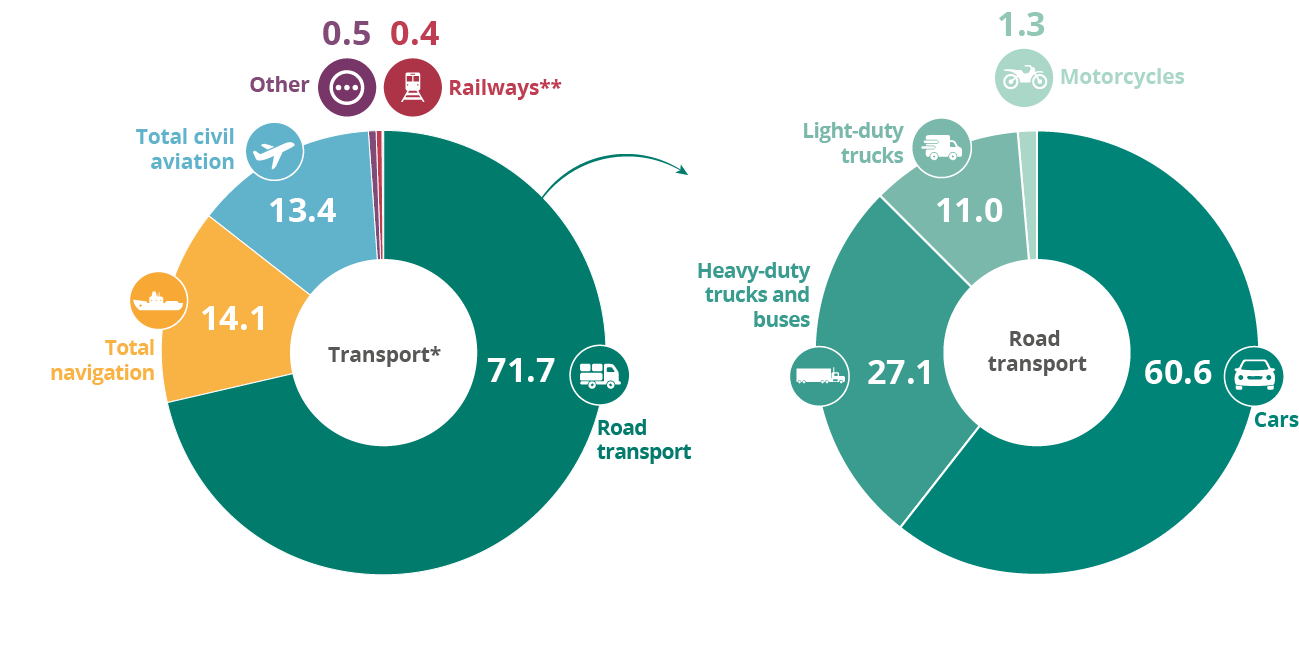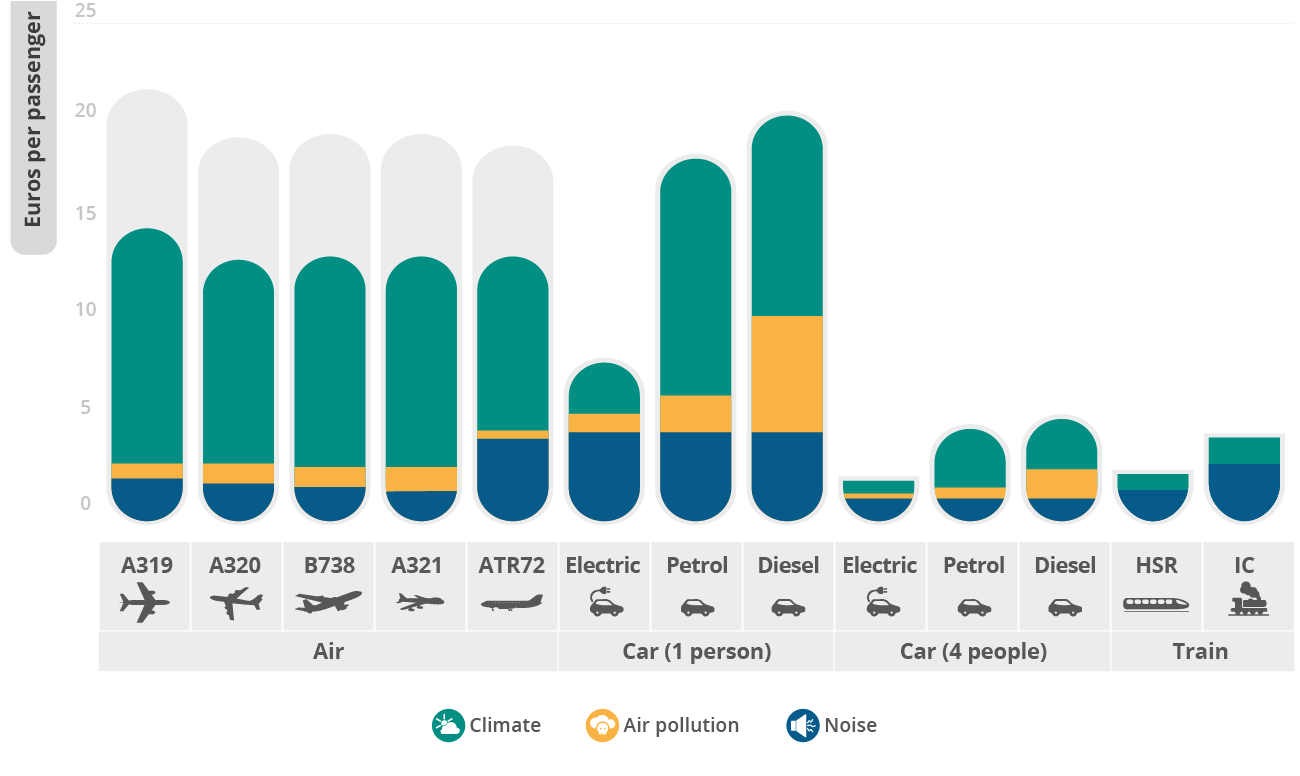Only a few generations ago, many people stayed in their local community throughout their life. They did not necessarily move many kilometres away from where they were born and most of the things they needed — food, clothing, building materials — came from their immediate surroundings.
In modern societies, systems of production and consumption depend on transport. People expect to be able to move around for their work and education. They visit family in other cities and travel to other countries for holidays. But, currently, energy prices, dependency on fossil fuel imports, and concerns about the climate and biodiversity crises give more than enough reason to rethink our mobility system.
Growing greenhouse gas emissions from transport
The EU has set an ambitious goal of reducing greenhouse gas emissions from transport by 90% by 2050, compared with 1990 levels. So far, however, it has proven difficult to achieve progress towards this goal. EEA data show that transport is the only major economic sector in the EU where greenhouse gas emissions have increased over the past 30 years.
Transport has generally become more efficient. Most cars, lorries, ships and planes emit less carbon dioxide per kilometre than previously. Their engines are more fuel efficient and run partly on biofuels. But those gains have not kept up with growing transport volumes. We drive more kilometres, transport more goods and take more flights for business and holidays. This is the main reason for total emissions from transport in Europe having increased.
Currently, transport accounts for about one quarter of the EU’s total greenhouse gas emissions. Out of these emissions, almost three quarters come from road transport, and more than half of road transport emissions come from cars. Civil aviation accounts for about 13% of greenhouse gas emissions in the EU transport sector, but these emissions are growing rapidly and have already more than doubled since 1990.
According to the EEA’s analysis, Europe’s transport emissions are projected to decrease with existing policy measures but not enough to bring them into line with the EU’s overall climate neutrality target by 2050.


Source: EEA Transport and environment report 2021
Transport puts major pressures on nature
Greenhouse gas emissions are not the only sustainability concern linked to transport. Air and noise pollution harm people’s health and nature. And growing transport volumes require a lot of infrastructure — roads, parking areas, harbours, canals, airports.
Expanding urban areas and transport networks slice natural habitats into smaller pieces. This reduces the ecosystem’s resilience and hampers the movement of wildlife. For example, animals may be run over by cars or unable to find food, water or a mate. According to an EEA indicator, landscape fragmentation currently affects even sparsely populated parts of Europe.
Maritime transport contributes to many cumulative pressures on Europe’s regional seas. The EEA’s recent joint report with the European Maritime Safety Agency was the first major assessment of the sustainability of the sector. The report identified shipping as a major contributor to the introduction of non-indigenous species, underwater noise, and greenhouse gas and air pollutant emissions.
Fact box: Biofuels
The share of renewables in powering transport in the EU reached 10.2% in 2020, meeting the 10% target set for the same year. Part of this energy came from biofuels that are linked to another EU target, which is to reduce the greenhouse gas intensity of fuels sold for road transport.
Biofuels can play a key role in decarbonising transport. However, it is important to ensure that rising demand for biofuels does not compromise the production of food and feed or convert land that is a carbon sink or stock — such as forests and wetlands — to a source of emissions.
The proposed revision of the EU Renewable Energy Directive promotes the sustainability criteria of bioenergy.
Many measures are needed
The roll-out of new and more efficient technology is expected to play a key role in decarbonising passenger and freight transport. This includes increasing the share of electric vehicles, coupled with a continued shift towards renewables in electricity and fuel production.
But the sustainability challenges of Europe’s transport sector cannot be solved by more efficient vehicles alone. The EEA’s recent assessment shows that, in road transport, fuller cargo loads and higher occupancy rates are needed, for example through ride-sharing. And the growth in transport demand needs to be curbed, as well as shifting to greener transport modes: walking, cycling, buses, trains and inland navigation. Importantly, the price of transport should fully reflect its costs to the environment, the climate and people’s health.
Cities especially have a lot to gain from investing in better options for public transport, cycling and walking. These measures can make moving around city centres quicker, improve local air quality and reduce greenhouse gas emissions.

Fewer cars can also mean that parts of roads or parking areas can be turned into green areas that people can enjoy and that reduce the worst effects of heatwaves and heavy rain. All this contributes to improving people’s health and well-being and can even support biodiversity in urban areas. Similarly, better city planning can reduce the need for transport.
©Laszlo Ligeti, My City /EEA
As part of the sustainable and smart mobility strategy, Europe aims to double its high-speed rail traffic. This could make an important contribution to reducing emissions and other negative impacts of European transport. A recent EEA assessment concluded that rail travel is clearly the most environmentally sound mode of transport between many European cities, compared with flying. And driving a petrol- or diesel-powered car, especially if travelling alone, can be even more harmful than flying.
For new cars and vans, the ‘Fit-for-55’ package proposes stricter emission limits, with only zero emission vehicles being registered from 2035 onwards and improvements in the alternative fuels infrastructure. The package also includes ReFuelEU Aviation and FuelEU Maritime initiatives that aim to reduce emissions from planes and ships, as well as extending EU Emissions Trading System to maritime and road transport.
Source: EEA Transport and environment report 2020.
Note: Occupancy rates: aircraft 80 %; HSR 66 %; IC 36 %. The gray bars reflect the uncertainty for the non-CO2 climate costs of aviation based on Cox and Althaus (2019).Cox, B. and Althaus, H.-J., 2019, How to include non-CO2 climate change contributions of air travel at ETH Zurich, Study on behalf of the Mobility Platform of ETH Zurich, INFRAS, Bern, Switzerland.
Towards more sustainable mobility
The mobility system is one of the core societal systems that define our current way of life. But it is also a system that currently depends on fossil fuels, and it harms our health, environment and climate.
The COVID-19 crisis taught many people new ways of working or even of spending holidays closer to home. Socially, we still need face-to-face interactions, but many would now question whether travelling to another city or country to attend a short meeting is worth it.
Reduced traffic in cities during COVID-19 also showed clear benefits for local air quality. Noise levels dropped, and there were many anecdotal accounts of wildlife acting differently when not disturbed by human activities.
Currently, high energy prices are making people take a good look at their mobility habits. Less important journeys may have to wait. The incentives to use ride-sharing, walking, cycling, public transport and more fuel-efficient vehicles are clearer. Decarbonising Europe’s mobility system requires investments in long-term sustainability that fully account for the negative impacts of transport and changes in our habits.



Document Actions
Share with others